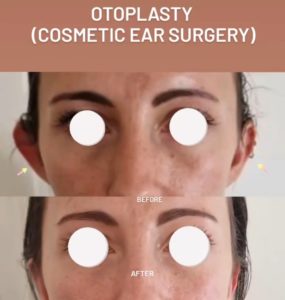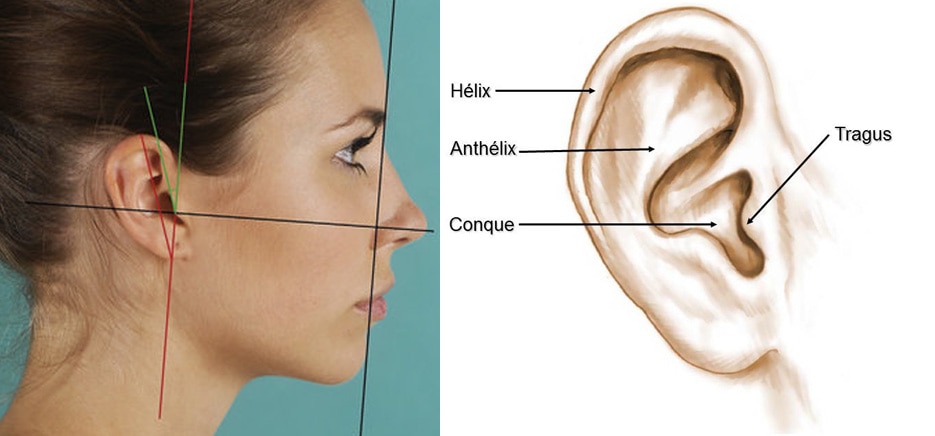Anatomy and ideal proportion :
The longitudinal axis of the ear should be inclined 20° posteriorly to the vertical (green angle) and should be inclined 15° anteriorly to the axis of the dorsum of the nose. The ear should be approximately 5.5-7 cm posterior to the orbital rim. The width should be equivalent to about 50-60% of its length (width 3-4.5 cm, length 5.5-7 cm). From the front, the helix should protrude 2-5 mm from the antherix.
Detached ears are due to 3 mechanisms:
- Faulty folding of the antihelix which is poorly defined, the auricle is thus smooth and projected forward
- Hypertrophy (excess) of the concha which causes a forward projection of the ear
- Angle behind the ear is too open between the skull and the concha
Otoplasty consists of reshaping these cartilage deformities with sutures. This procedure can classically be done as early as 7 years old, when the ear reaches its final size and when the cartilages have finished growing.
Technique:
The procedure is performed under local anesthesia (usually in adults) or general anesthesia (in children or even in adults for comfort).
The scar is marked behind the ear. Then, the cartilage is remodeled: an excess of concha is corrected by revoking it, the plicature defect of the antihelix is corrected by rapping the cartilage in order to make it model and stitches are made in the cartilage to recreate the plicature of the antihelix and when it is necessary, the posterior angle between the concha and the skull is closed by making posterior stitches
EarfoldIf there is only a folding defect of the antihelix without excess of the concha, the Earfold can be used. This is a 15 mm long, 1 mm thick implant made of a nickel-titanium alloy coated with 24 carat gold, which is inserted through an 8 mm incision under local anesthesia.
The procedure lasts 20 minutes and has the advantage that the patient does not need a postoperative bandage.
Results:
Time to final results:
2 weeks to see a significant result, 2 to 3 months to see the final result (discreetly pink scar for 1 to 2 months)
Longevity of results :
Definitive
Before surgery:
Stop smoking 1 month before the operation (risk of skin necrosis important if active smoking).
Do not take Aspirin 10 days before surgery, inform Dr. Lucas of any anticoagulant medication (Sintrom, Coumadin, Eliquis, etc.) in order to arrange for its discontinuation or replacement.
Take Arnica capsules 5 capsules 5 times a day for 5 days before surgery to prevent hematoma.
Intervention :
Pain: the pain during the intervention will be almost non-existent, with an adapted anesthesia
Duration of the procedure: 90 minutes (20 minutes for Earfold®)
Anesthesia: local
Location: operating room
Outpatient
After surgery:
Post-operative pain: 1/10 often responding to Dafalgan
Social eviction :
7 days with swelling and hematoma
Suture removal: 2 weeks
Return to work: 8 days
Return to sport: 6 weeks for endurance sports, 10 weeks for contact sports
Instructions:
Bed rest without major effort (which can cause the opening of small vessels during effort and lead to a hematoma) for 48 hours
Ice for 1 week, as often as possible, to reduce swelling
Arnica capsules 5 times a day for 5 days after surgery to prevent hematoma
Permanent cessation of smoking to prolong the effect of the surgery and minimize complications
Headband for 3 weeks day and night, then 3 weeks at night only (no headband after Earfold®)
Dr Lucas check-up on D1, D7, 3 weeks, 3 months, 6 months, 1 year.
Sun protection with an index greater than 50 for 6 months following surgery.
Follow-up of the scar by Dr Lucas for 1 year after surgery is essential.
Complications
– Hematoma, infection
– Pain or even localized skin necrosis, responsible for a delay in healing (the risk is increased by smoking intoxication).
– Abnormal, hypertrophic or even keloid scars, of unpredictable appearance and evolution, can compromise the aesthetic aspect of the result and require specific local treatments. Regular follow-up is essential.















